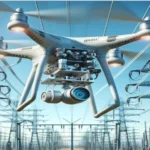In recent years, the rise of e-commerce has dramatically increased the demand for faster, more efficient delivery methods. As a result, traditional delivery systems have faced challenges like traffic congestion, rising costs, and environmental concerns. Consequently, delivery drones have emerged as a revolutionary solution, offering the potential to transform the last-mile delivery process.
What Are Delivery Drones?
Delivery drones are unmanned aerial vehicles (UAVs) designed to transport goods from distribution centers to customers in a faster and more efficient manner. These drones can carry small to medium-sized packages and are typically equipped with GPS, sensors, and cameras to navigate through various environments. By flying above traffic, drones can deliver goods directly to customers’ doorsteps, providing an alternative to traditional delivery methods.
The Advantages of Delivery Drones
1. Faster Delivery Times
One of the most significant benefits of delivery drones is their ability to drastically reduce delivery times. Unlike traditional delivery vehicles, which face traffic delays, drones can bypass road congestion. Therefore, drones can make deliveries in a fraction of the time it would take for trucks or vans.
2. Reducing Costs for E-Commerce Businesses
Delivery drones offer a more cost-effective solution for e-commerce businesses, especially for last-mile delivery. In comparison to traditional delivery systems, which incur high operational costs such as fuel and vehicle maintenance, drones can significantly reduce these expenses. As a result, businesses can operate more efficiently and offer lower delivery costs to consumers.
3. Eco-Friendly Alternative
Environmental concerns are becoming increasingly important. Delivery drones, unlike gas-powered vehicles, are powered by electricity, which significantly reduces their carbon footprint. Thus, they offer a sustainable solution to the growing demand for eco-friendly alternatives in the logistics industry.
4. Access to Remote Locations
Delivery drones also provide access to remote or hard-to-reach areas. In regions where traditional vehicles may struggle to navigate, drones can deliver packages safely and quickly. Therefore, drones offer a way for e-commerce businesses to expand services to regions that were previously underserved.
How Delivery Drones Work
Delivery drones operate through a combination of advanced technologies. Here’s how the process generally unfolds:
- Order Placement: When a customer places an order online, the system processes the order and determines the nearest distribution center or warehouse.
- Drone Activation: A drone is dispatched from the distribution center with the customer’s order.
- Flight Path Planning: Using GPS and flight algorithms, the drone selects the quickest and safest route to the destination.
- Package Delivery: Upon arrival, the drone delivers the package to the customer and returns to the distribution center.
Throughout the entire process, drones are monitored by a command center, ensuring that deliveries are made safely and efficiently.
Challenges and Concerns
While delivery drones hold significant promise, there are still several challenges to overcome.
1. Regulatory Issues
One of the biggest hurdles for delivery drones is navigating complex regulations. As more drones enter civilian airspace, the need for safety and privacy regulations increases. In response, governments are gradually establishing frameworks to allow drones to operate safely in shared airspace.
2. Limited Payload Capacity
Currently, delivery drones are limited by the weight of the packages they can carry. While drones are ideal for smaller packages, their capacity is not yet sufficient for larger or heavier items. Therefore, drones are best suited for lightweight goods such as electronics or small consumer products.
3. Public Safety and Privacy Concerns
As drones become more common, concerns about public safety and privacy will likely rise. For example, drones flying over private properties may raise questions about surveillance. To address these concerns, companies need to ensure their drone operations respect privacy laws and maintain high safety standards.
The Future of Delivery Drones
Despite the challenges, the future of delivery drones remains promising. With advancements in technology, drones will likely become more efficient and capable of carrying larger payloads. Additionally, regulatory frameworks are evolving to accommodate these innovations. As a result, drones could soon be a common sight in the skies, revolutionizing the logistics and e-commerce industries.
Conclusion
Delivery drones are not only transforming the logistics industry but also reshaping the way we think about last-mile delivery. By offering faster, more cost-effective, and eco-friendly solutions, drones are poised to redefine the future of e-commerce. While there are still challenges to overcome, the potential benefits make them an exciting development in the world of technology and logistics.




